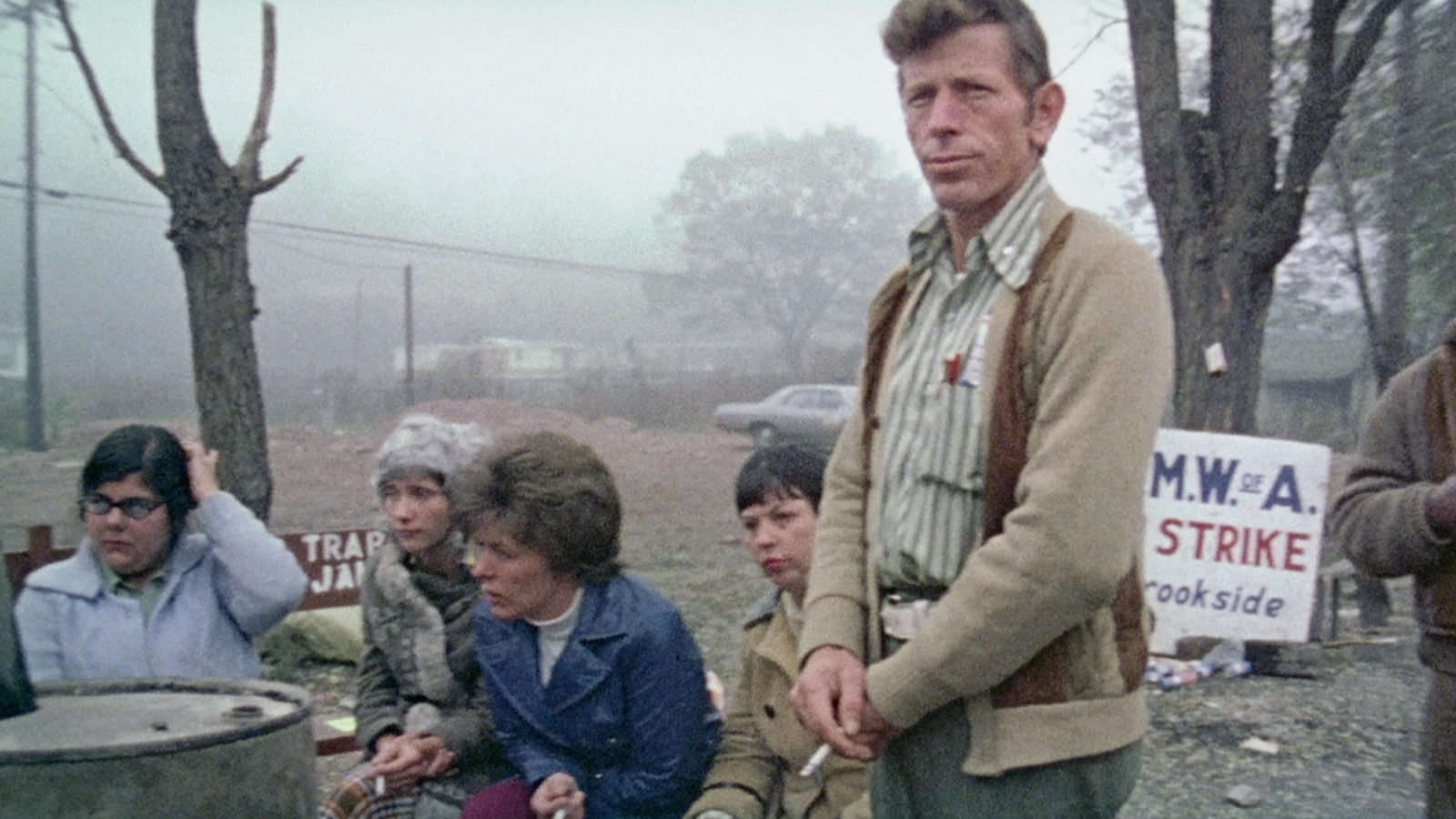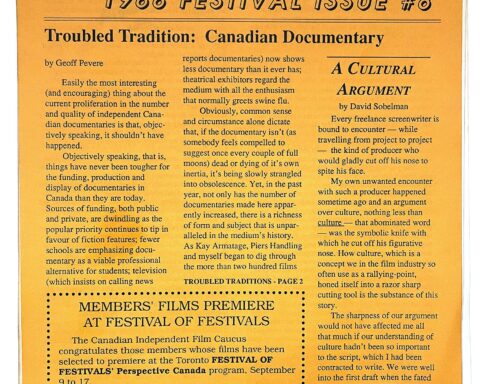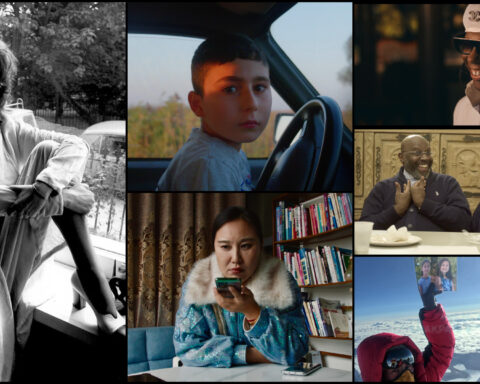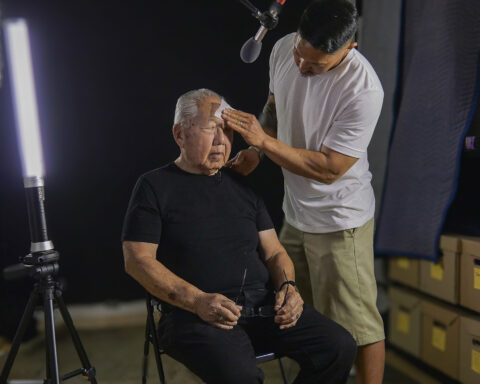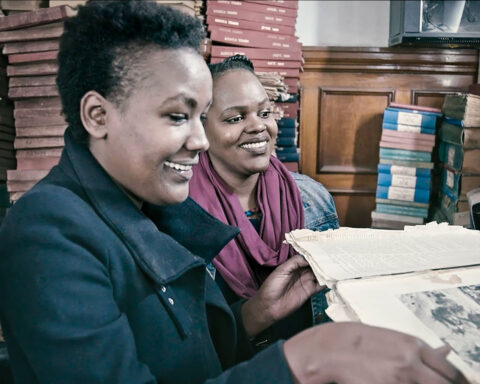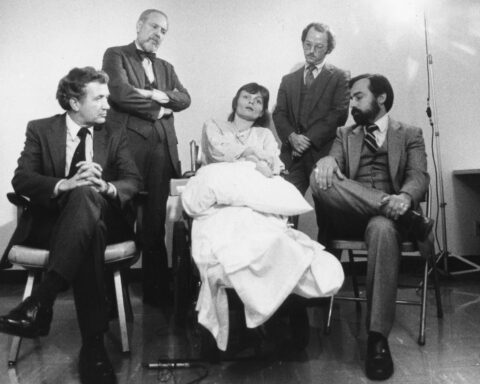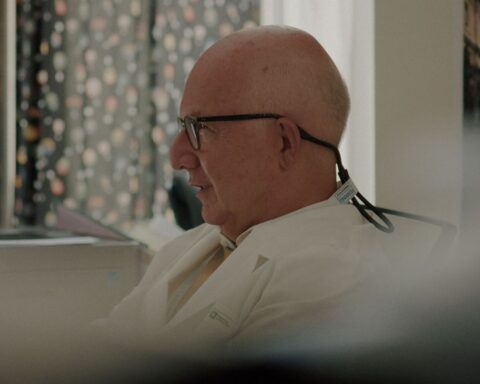“Only in America, in a free democracy like America, would it have been possible to make a film like American Dream,” said producer Arthur Cohen while accepting the Oscar for American Dream in 1991. “I feel today, more than ever, the free world owes the United States of America deep respect and everlasting gratitude.”
Standing beside Cohen and nodding all the while was American Dream director Barbara Kopple. Should Kopple win another Oscar within the next few years, one wonders if she would repeat Cohen’s words. Perhaps she might. There are few flattering portraits of the United States at Hot Docs this year, but some of the most vital and useful are in the Kopple retrospective. Her films offer tough but patriotic portraits of a complicated nation.
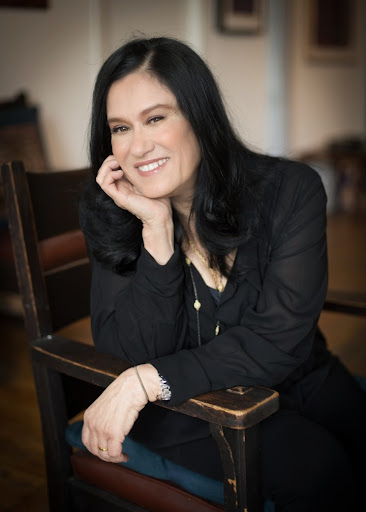
Barbara Kopple, this year’s Outstanding Achievement Retrospective recipient at Hot Docs, has always made films that encapsulate the contradictory greatness of the United States. Her roots in verité imbue her work with the power of observation. Kopple’s films give voice to Americans who are silenced by the establishment and the status quo. They invite audiences to find empathy by seeing the world from another’s perspective. Her films show that a nation isn’t defined by the person or party in power, but by the everyday people working together to ensure the American dream isn’t reserved for a lucky few.
Kopple’s story is one of grassroots style and participatory filmmaking. What best defines her work is the astonishing range of access she gets to her subjects and the intimate environments she creates. This facet starts with her early Oscar winners Harlan County, USA and American Dream where she entered the homes and lives of the people whose stories she filmed. Despite gaining a reputation as a savvy fundraising, Kopple’s filmmaker diaries are accounts of the documentarians’ vow of poverty—stories of single-digit account balances, blackouts, and shoots saved by credit cards—and, in one case, Bruce Springsteen. This spirit, particularly in the story of the miners’ strike in Harlan County, USA, ensures that the work resonates with the hardship the subjects endured.
Even in her late career shift towards music docs and celebrity portraiture, Kopple’s work remains quietly political. Films like Shut Up and Sing and Miss Sharon Jones! transcend the populist appeal of music docs by looking beyond the success stories of their subjects and finding greater interest in the social forces that fuel the musicians’ fires. The accessibility of these stories is often intertwined within the power of music used so effectively in Kopple’s films. Her work registers as powerful emotionally as it does intellectually, and perhaps that accounts for its longevity. One leaves each film invigorated to make the world a better place.
Hot Docs offers a sextet of Kopple classics as part of this year’s Outstanding Achievement Award retrospective: Harlan County, USA; A Conversation with Gregory Peck; Shut Up and Sing; Running from Crazy; Miss Sharon Jones! and a mystery selection by the director herself. The five films are great choices for viewers to discover Kopple’s hand at verité, her activist spirit, adept portraiture, and the emotional resonance she imbues in each work, but the selections are also the titles of her filmography that one can see easily outside the festival. Some of her best films, like American Dream, Wild Man Blues, and My Generation, are hard to find. One hopes this long-overdue retrospective inspires more distributors to support her work and more festivals to show her older doc classics.
Here are some highlights from Kopple’s filmography that make her a worthy choice for this year’s Outstanding Achievement Award:
Winter Soldier (1972)
Kopple was part of the Winterfilm collective that shared directing credits on this difficult documentation of the 1971 Winter Soldier hearings in Detroit. The doc, overlooked at the time but re-released and re-appraised in 2005, gave the USA a portrait of the war effort it didn’t want to see, but desperately needed to view and process at that time. Kopple and company filmed the testimonies of 30 Vietnam veterans, including future Secretary of State John Kerry, as they unburdened themselves of the atrocities committed by American soldiers against the Vietnamese. Winter Soldier, difficult to watch even 50 years after its production, offered gut-wrenching accounts of civilians maimed, raped, tortured, and executed in brutal acts of senseless violence. Equally disturbing were the soldiers’ recollections of dehumanization tactics used to characterize all Vietnamese as the enemy “other.” Shot in inky black and white, the frank and sobering style of Winter Soldier found the right counter-culture voice to tell the survivors’ stories: by unmasking the image of the all-American hero and seeing the wounded soul underneath.
Harlan County, USA (1976)
Barbara Kopple’s invigorating solo directorial debut Harlan County, USA introduced a brilliant voice for verité. Immersing herself within the community of Kentucky coal miners going on strike against the Duke Power Company, Kopple brought her camera to the front lines of a tense stand-off between the haves and the have nots. Much has been written of the violence Kopple experienced during the film, and one can’t forget the image of a Duke goon pointing a gun at the crew while the director’s voice screamed “Don’t shoot!” from off-camera, but that is simply one facet of the doc’s astonishing fearlessness. The film didn’t give both sides of the story and it didn’t have to, for the powers at Duke already got their fill in the mainstream media. Kopple instead created an air of objectivity by capturing the plight of the miners from a variety of perspectives. In addition to the men, Harlan County gave equal weight to the wives of the miners, who fought boldly on the picket lines and squabbled at meetings in-between.
The power of the film is best encapsulated in a scene in which 73-year-old singer Florence Reece rallied the troops at a town hall with a gravelly rendition of her labour ballad “Which Side Are You On?.” The song, one of many folk tunes that peppered the soundtrack, evoked an enduring spirit of Americana that let the film resonate with each fight to come. Kopple chose her side and Harlan County, USA was all the better for it. Harlan County is not only Kopple’s best film, it is, in my opinion, the best documentary ever made.
American Dream (1990)
If Harlan County, USA is folk music, American Dream is Springsteen. Kopple followed Harlan County with a portrait of labour and the working class in American Dream that echoed the plight of the miners as it witnessed the meatpackers at a Hormel Foods factory in Austin, Minnesota. This strike marched into frigid winter when the brass cut workers’ wages despite an increase in profitability. Kopple portrayed the dissolution of the unions’ strength by observing three complementary but distinct narrative threads as the workforce found itself at odds with its elected representatives in addition to the executives who forced them to picket in the cold. Through these layers, the film saw the erosion of the union’s power and the division of the community. If the in-fighting of Harlan County was dramatic, the fissures between union members of American Dream proved explosive while capturing the devastating impact of Reagan-era economics on the working class. The emotions became charged when hope grew as cold as the Minnesota winter and, in a disarming moment, Kopple’s camera was privileged to sit at the kitchen table with a few salt-of-the-earth meatpackers as they shed tears and weighed their need to feed their families with the price of crossing the picket line. Again embedding herself within the homes and lives of the subjects whose story she presented, Kopple asked how the democratic spirit of organized labour could withstand the nation’s pursuit of unfettered capitalism.
Wild Man Blues (1997)
Any Woody Allen fan is bound to love the power of music as the Woodman sways playing his clarinet in Kopple’s behind-the-scenes flick Wild Man Blues. The doc followed Allen on a whirlwind European tour as he played blues and jazz for delighted audiences—and escaped media scrutiny over his notorious relationship with ex-girlfriend Mia Farrow’s adopted daughter Soon-Yi Previn. Kopple didn’t take sides once again but simply observed the relationship between Allen and Previn, including his off-colour jokes about her teenage friends and her childhood spent eating garbage in Korea. More significantly, Wild Man Blues offered the first chance for audiences to listen to Ms. Previn speak. Kopple’s doc afforded her agency that mainstream news outlets did not. Previn, despite her youthfulness, often appeared to be the more mature member of the couple, as in one scene where she taught Allen the value of thanking his band at the end of the show—a gesture he hadn’t even considered and failed to make after his next performance.
The objective power of verité-style filmmaking found one of its best examples in Kopple’s observation of the relationship that let viewers decide the ick factor for themselves. One couldn’t help but laugh in the film’s climax when Kopple witnessed the “dinner from hell” as Allen visited his parents, who insisted that his career would have been better spent in pharmaceuticals. Allen’s mother lamented his choice to date an Asian woman rather than a “nice Jewish girl,” but made no quip over Previn’s much younger age. The scene provided a great snapshot of the home that produced Allen’s neurotic comedy. Wild Man Blues offered a hilariously uncomfortable portrait of an icon in all his complexity.
A Conversation with Gregory Peck (1999)
Kopple profiled another icon of American cinema two years later as she filmed actor Gregory Peck on an in-conversation tour across the country. Peck, best known for his iconic and Oscar-winning performance as Atticus Finch in To Kill a Mockingbird, carried himself in Kopple’s verité with the same dignity and grace that defined his star persona. In Peck, just as in Atticus Finch, Kopple found an embodiment of all-American values and goodwill as he regaled the audience both onstage and offstage with stories about his life on screen. The doc affectionately let audiences into the lives of one of Hollywood’s favourite actors and challenged the idea that people shouldn’t meet their heroes. Sometimes the ideal could be real.
My Generation (2000)
The hidden gem of the Kopple canon is her expansive chronicling of Woodstock in My Generation. Kopple’s doggedness for keeping the cameras rolling regardless of funding came in handy when Polygram brought her on to film its 1994 reboot of Woodstock but then “got cold feet,” as Kopple said, and tried to stop the shoot. Any delay in the production was in her favour, though, since Kopple then shot the last Woodstock of the Millennium in 1999 and captured the seismic shifts in cultural values encapsulated by the all-out bastardization of the-once groovy fest. This sweeping tapestry wove the social history of music and Americana by cross-cutting archival footage of the 1969 Woodstock concert and the 25th anniversary effort that tried to re-capture the magic for a new generation. What Kopple found, however, was a change in tune for Woodstock as corporate culture overwhelmed the concert with sponsorship, merchandise, prohibitively expensive tickets and concessions, and an overall jaded attitude. Where Woodstock once embodied the way-out hopefulness of free love and idealism, the concert morphed from acoustic lovefest to plugged-in rage against the machine. American youths came looking for solace from the fast-paced consumer culture their parents created and found no escape.
Shut Up and Sing (2006)
There are two great documentaries from the Bush years that capture the politics and spirit of the era: Michael Moore’s Fahrenheit 9/11 and Kopple’s Shut Up and Sing. This remarkable film went behind the scenes with the Dixie Chicks when they fell from the top of the charts after singer Natalie Maines joked in a London concert that she was ashamed that the President of the United States was from Texas. The film watched as fans, nudged by the alt-right group The New Republic, charged the all-American girls with treason via trial by media. Radio stations encouraged fans to burn their Dixie Chicks albums, yet the doc witnessed the band hit new creative heights by channelling the experience, which included legitimate death threats against Maines, into music.
It is crazy how well Shut Up and Sing anticipated the polarity of Donald Trump’s America. A revisit to the film in 2018 brought chills with its story of the power of the alt-right using sensational rhetoric and the guise of patriotism to silence democracy. Even before the toxicity of Twitter, hate for the Chicks fuelled all-American rage. But in cross-cutting the nightmare of 2003 with scenes of the band’s 2005 renaissance, Kopple and co-director Cecilia Peck (Gregory’s daughter) ensured that the positive power of free speech ultimately spoke louder than the voices who sought to silence the band. Shut Up and Sing became more relevant than ever as time passed with its buoyant, anthemic message about the virtues of a country in which people can debate their ideals and become stronger together.
Running from Crazy (2013)
Some critics cynically dismissed Running from Crazy as mere stargazing with its glimpse into the public and private life of actress Mariel Hemingway and her family’s history of suicide, including her famous grandfather, Ernest. However, while Running from Crazy offered a sunny and balanced portrait of Hemingway, it really delivered a disarming look at the ways mental illness can impact a family. Kopple mined the rich archive of Hemingway lore to unearth audio interviews of Mariel’s sister Margaux, a superstar model/actress who tragically took her own life at age 46, and revealed through interviews the younger sister’s indifference towards her sibling during her lifetime. The doc offered an invaluably intimate study on the possibility to escape such a cycle of despair by showing Hemingway’s willingness to speak openly about her past and encourage others to do the same.
Miss Sharon Jones! (2015)
Kopple found the best subject in her streak of celebrity portraits with the late soul sister Sharon Jones. The doc went behind the scenes with Jones’s late-breaking career to show how hard it is for a woman to make it in show business when she defies the conventional model for being petite, blond, and white. Miss Sharon Jones! sang with lust for life as Jones belted out numbers by night and endured treatment for cancer by day, and Kopple’s verité eye never wavered while another part of her body was tapping its toes. Cancer was just another knock for Sharon Jones after being told she was “too fat, too black, and too short” to make it in entertainment. The film showed a life well-lived in its observation of her determination and tenacity to claim the spotlight her talent deserved.
This is Everything: Gigi Gorgeous (2017)
Four decades after Harlan County, USA Kopple delivered not one but two films in 2017 with This is Everything: Gigi Gorgeous and A Murder in Mansfield, the latter of which trickled onto the festival circuit late in the year and is still continuing its run. Kopple showed that she couldn’t be aged out of a rapidly changing art form as she profiled Toronto-born YouTube influencer Gigi Gorgeous (née Gregory Lazzarato), who became a viral sensation by posting “how to” make-up videos at an early age and invited strangers to watch her transition from male to female. The film, a YouTube Red original, showed the positive impact the web could have for giving voice to marginalized communities as Kopple chronicled numerous people thanking Gigi both in person and online for helping them find hope. The film also revealed how the democratization of technology helped one generation make sense of another as Kopple found in Gigi’s father David an incredibly supportive figure who waded outside his relatively conservative comfort zone and provided the voice of love that any son or daughter would hope to hear. This is Everything: Gigi Gorgeous caught a much different fight than Kopple saw in Harlan County, but one that was every bit as relevant in representing voices outside the mainstream.
Conclusion
Kopple learned filmmaking from the great Albert and David Maysles when a single course in cinema verité inspired her to pursue an internship with them. After shadowing the masters on films such as Salesman and Gimme Shelter, Kopple quickly matched the calibre of her teachers with Harlan County, USA, which came out shortly after the Maysles’ Grey Gardens. Like the Maysles, Kopple has filmed everything from great musical concerts to profiles of eccentric characters to films that proved socially and artistically influential. She’s taught students who became top doc makers like Brett Morgen, Lucy Walker, and Nanette Burstein, and her influence has reach countless students inspired by the power of Harlan County. 40 years, nearly 40 docs, and two Oscars later, few voices have toughed it out in documentary as powerfully and prolifically as Kopple has, and one would be hard pressed to find a woman director with such success and longevity. In a festival unofficially celebrating women behind the camera, Hot Docs couldn’t have found a better filmmaker to spotlight this year.
Get showtimes for the Hot Docs Outstanding Achievement Retrospective here.
Hot Docs runs April 26 to May 6. Please visit hotdocs.ca for more info.




